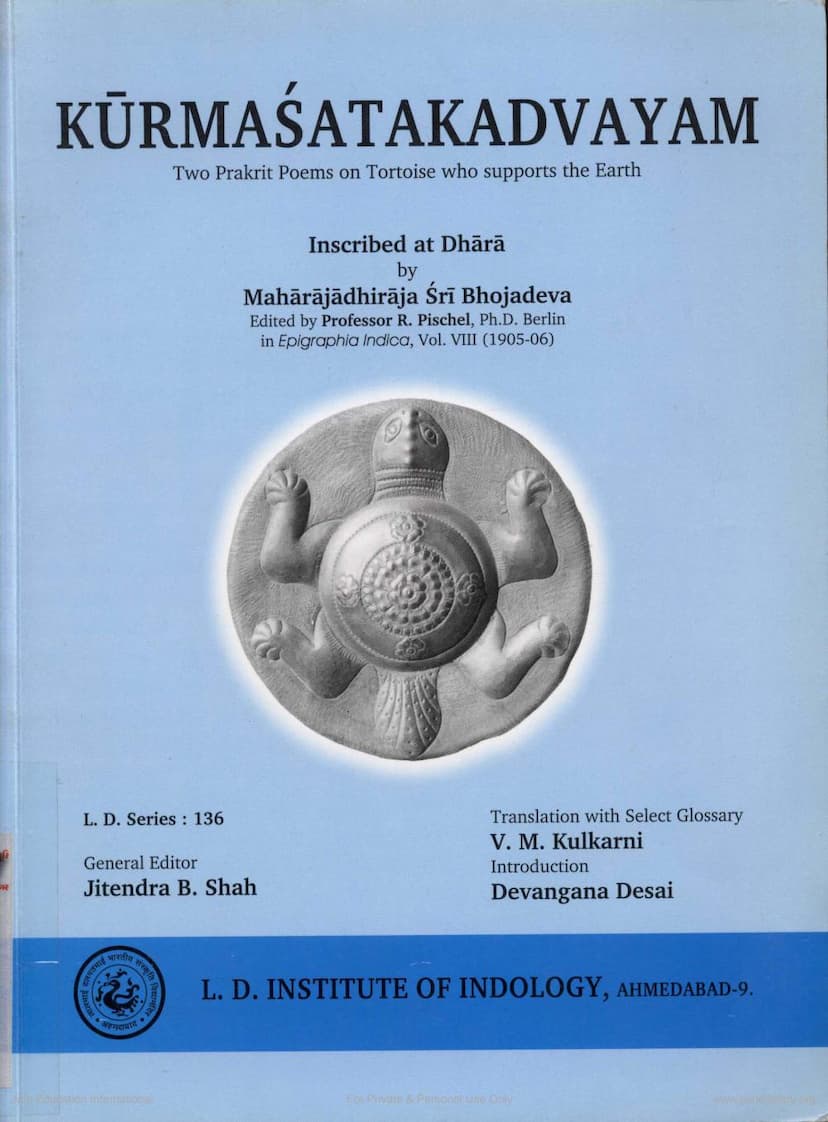Kurmastakadvyam
Added to library: September 2, 2025

Summary
Here's a comprehensive summary of the Jain text "Kurmasatakadvayam" based on the provided pages:
Title: Kurmasatakadvayam (Two Prakrit Poems on the Tortoise who supports the Earth)
Author: Attributed to Mahārājādhirāja Śrī Bhojadeva (c. AD 1000-55)
Publisher: L. D. Institute of Indology, Ahmedabad
Editors/Translators/Contributors:
- Original Editor of Prakrit Text: Professor R. Pischel, Ph.D. (Berlin) in Epigraphia Indica, Vol. VIII (1905-06)
- Translation and Select Glossary: V. M. Kulkarni
- Introduction: Dr. Devangana Desai
- General Editor: Jitendra B. Shah
Summary:
"Kurmasatakadvayam" is a publication by the L. D. Institute of Indology, Ahmedabad, presenting a fresh edition and English translation of two Prakrit poems (Śatakas) composed in the Āryā meter. These poems, each consisting of 109 stanzas, are inscribed on a stone slab found at Dhārā, the capital of King Bhojadeva of Mālavadeśa.
Key Themes and Significance:
-
The Tortoise as the Earth-Bearer (Dharanidhara): The central theme of both poems is the tortoise's role as the support of the Earth. This interpretation deviates from the more commonly known Kurma avatar of Vishnu supporting Mount Mandara during the Churning of the Milky Ocean. Instead, the poems focus on the tortoise as the cosmic pillar holding up the entire world.
-
Attribution to King Bhojadeva: The poems are attributed to the renowned scholar-emperor Bhojadeva, known for his patronage of arts, literature, and sciences. The introduction suggests that while attributed to him, the actual composition might have been done by his court poets. The second poem, in particular, praises King Bhoja himself for surpassing even the tortoise in supporting the earth.
-
Kūrma Symbolism: The work delves into the rich symbolism of the tortoise in Indian tradition. The tortoise symbolizes stability, self-control, and restraint, virtues highly valued, especially in troubled times. The poems explore the idea of the tortoise as the support of the earth and, by analogy, the king as the support of his kingdom.
-
Rare Inscribed Poetry: These Śatakas are significant as they represent a rare extant example of poetry inscribed on stone in ancient India. Other known examples also found at Dhārā are mentioned, such as the Khadga Sataka and Kodandakavya.
-
Comparison with Other Beings: The poems compare the tortoise's quiet, selfless endurance in supporting the Earth with other mythological figures like the Boar (Varāha), the cosmic Serpent (Śeṣa), and the Diggajas (elephants of the quarters). The tortoise is often portrayed as superior due to its silent dedication and lack of ostentation.
-
Praise for the Tortoise's Nature: The first poem, "Avani-Kūrma Sataka," specifically praises the tortoise for its unwavering devotion to doing good to others, its self-control, and its steadfastness. It highlights the tortoise's ability to withdraw its limbs, mirroring a sage's (muni's) detachment and firm resolve.
-
King Bhoja's Superiority (in the Second Poem): The second poem, while acknowledging the tortoise's strength, shifts focus to King Bhoja. It poetically elevates Bhoja, suggesting he makes the immensely heavy earth feel light and that his prowess in supporting the earth far surpasses that of the tortoise and other legendary beings. This might reflect the medieval Indian concept of royalty and regal power being metaphorically linked to the Boar avatar, but here extended to the king's own capabilities.
-
Invocation to Śiva: Both poems begin with an invocation to Lord Shiva, which is common in ancient Indian literature, demonstrating the religious context of the compositions.
-
Mythological and Cosmic Significance: The poems touch upon cosmic symbolism, referring to the tortoise as the "golden mountain Meru" and the "bulbous root of the creeper of the old." The reference to Dhruva (the Pole Star) further establishes the tortoise's role in supporting the cosmic axis.
-
Translation and Scholarly Effort: The publication is a result of scholarly endeavor, with V. M. Kulkarni undertaking the translation and providing a glossary. Dr. Devangana Desai's introduction contextualizes the poems within Indian art and mythology. The L. D. Institute of Indology is commended for making these historically and culturally significant poems accessible to a wider audience.
In essence, "Kurmasatakadvayam" offers a unique perspective on the tortoise as a symbol of selfless support and dedication, linked to the ideals of kingship and cosmic order, as depicted in a rare inscribed work attributed to the illustrious King Bhojadeva.